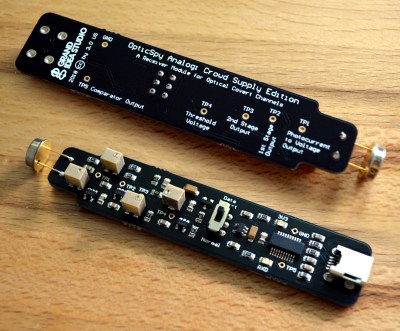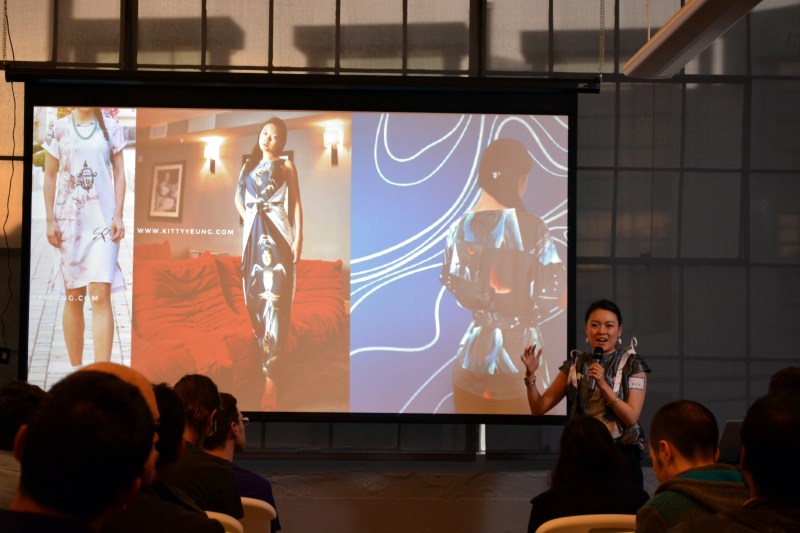Thursday night was a real treat. I got to see both Joe Grand and Kitty Yeung at the HDDG meetup, each speaking about their recent work.
Joe walked us through the OpticSpy, his newest hardware product that had its genesis in some of the earliest days of data leakage. Remember those lights on old modems that would blink when data is being transmitted or received? The easiest way to design this circuit is to tie the status LEDs directly to the RX and TX lines of a serial port, but it turns out that’s broadcasting your data out to anyone with a camera. You can’t see the light blinking so fast with your eyes of course, but with the right gear you most certainly could read out the ones and zeros. Joe built an homage to that time using a BPW21R photodiode.
Transmitting data over light is something that television manufacturers have been doing for decades, too. How do they work in a room full of light sources? They filter for the carrier signal (usually 38 kHz). But what if you’re interested in finding an arbitrary signal? Joe’s bag of tricks does it without the carrier and across a large spectrum. It feels a bit like magic, but even if you know how it works, his explanation of the hardware is worth a watch!
The demos of OpticSpy pulling data out of a seemingly solid red LED were a blast to see. I’m glad that Joe also spend time walking through the circuit:
 He mentioned that he doesn’t always get to stretch his analog design chops and this was a good project for it. Likewise, I enjoy working my way through the schematic, which uses a double-stage amplifier to condition the signal from the optical sensor. The final stage is a comparator which spits out the digital signal. Not shown in the screenshot above is the FTDI chip that takes this signal and spits it out to your serial terminal.
He mentioned that he doesn’t always get to stretch his analog design chops and this was a good project for it. Likewise, I enjoy working my way through the schematic, which uses a double-stage amplifier to condition the signal from the optical sensor. The final stage is a comparator which spits out the digital signal. Not shown in the screenshot above is the FTDI chip that takes this signal and spits it out to your serial terminal.
 Joe admits that it’s hard these days to find LEDs leaking data, so he got to make his own artificial sources. His demos included using the Parallax open conference badge, a laser diode driven by an Arduino, and Tomu, a microcontroller breakout board that hides in your USB port. The four trimpots allow for adjustment of the stages, something Joe had to do for the talk as the front of the room was getting blasted by the afternoon sun.
Joe admits that it’s hard these days to find LEDs leaking data, so he got to make his own artificial sources. His demos included using the Parallax open conference badge, a laser diode driven by an Arduino, and Tomu, a microcontroller breakout board that hides in your USB port. The four trimpots allow for adjustment of the stages, something Joe had to do for the talk as the front of the room was getting blasted by the afternoon sun.
Following Joe’s presentation, Kitty Yeung took the stage. A PhD in Applied Physics, Kitty’s talent spans many areas and she is likely to introduce herself to you as a creative technologist. You may have bumped into her at this year’s Bay Area Maker Faire wearing a shoulder-mounted solar panel, but her wearable creations are well known beyond the maker community having had multiple designs shown during 2016 San Francisco Fashion Week.

During her talk Kitty showed off an amazing dress which used LEDs in the garment to light up different constellations. These were controlled by gestures that can be retrained based on the wearer’s preference. The effect is delightful, especially because it is designed to complement her own paintings woven into the garment material.
Unfortunately the labor that goes into creating such a piece means that the idea is difficult to scale. In the image above, Kitty is showing off three of her designs that she has already taken to market. They include her paintings, but not the technology she likes to add to her works. I find her open challenge quite interesting. Right now, anyone can order custom print fabrics. You can even place orders for garments that have mix-and-match components, like different cuts for the sleeves. Kitty wonders what will it take to bring eTextile technology to low-run manufacturing and looks to the engineering community to bring this to reality.
Unfortunately I don’t live in San Francisco, so it’s a rare treat to attend the Hardware Developer’s Didactic Galactic — a monthly meetup focused on developing electronic hardware that takes place each month at Supplyframe’s San Francisco office. There are always featured speakers like Kitty and Joe, but the audience that shows up is a great group of engineers working in all different parts of industry. If you’re in the area, this is a can’t-miss event.
















It’s been known for a while that it’s possible to passively eavesdrop on conversations in rooms with windows. The windows resonate by sound of conversations and can be “heard” by “listening” to light reflecting from them. It’s best to bounce a laser off of the target window, and that laser can be infrared. See: https://lifehacker.com/5961503/build-a-laser-microphone-to-eavesdrop-on-conversations-across-the-street
Sure seems like someone didn’t read the article.
I think they’re just mentioning an alternate use for similar tech on a tangent from the article.
Applied Science tried this: https://www.youtube.com/watch?v=1MrudVza6mo
Joe is also behind the Jtagulator.
This is old ?
I’ve seen this ages ago:
https://www.ted.com/talks/harald_haas_wireless_data_from_every_light_bulb/
Streaming HD video trough a lightbulb…
Not seen in the wild tho, Probably because its to cheap to make profit on it.
I’d imagine there would be a quagmire involved in using this as such a high-bandwidth network reliably in real-world conditions, too.
Why are these two separate articles crammed into one, and then only the first mentioned in the title? If you’re interested in the second half but not the first, you’d never find it!
I wondered the same thing.
Sort of like a HackaDay Links article, but without the Benchoff…
Years and years ago, I remember some art project video where someone stuffed a photodiode in an old motion picture film camera and a similar circuit to Grand’s above and then drove around NYC looking for things that made interesting sounds. Most of the interesting sounds came from matrix displays, although the drone of HPS/Hg/fluorescent arc lamps was a unifying theme.
Can’t seem to find it now.
Oh that’s strange. I was talking to someone about that a few days ago. I think it was Eric Archer who did it, but I’m not totally sure. His website is a shadow of its former self, but one could give the Wayback Machine a try…
Oh, excellent! https://vimeo.com/11885641 is the video I was thinking of
[none of my replies are showing up.. let me try one more time]..
If you would like to read about an early example of such a circuit please check out Forrest Mims ‘Circuit Scrapbook Vol 1’.. It is the one Mims book I find truly inspirational from beginning till end even after all these years.. He has many projects of the same nature. Thank you.
(replied to wrong post… DOH!)
https://en.wikipedia.org/wiki/Infrared_Data_Association
There are always these two interesting titbits (from 2002!):
https://www.cnet.com/news/researchers-blinking-leds-leak-info/
http://www.applied-math.org/acm_optical_tempest.pdf
At the ISP where I worked, extra care was taken to ensure that switches were never facing areas where they could be observed. We were using mostly Extreme Networks’ gear at the time, all of it vulnerable to optical tempest attacks.
Recently:
https://arxiv.org/ftp/arxiv/papers/1706/1706.01140.pdf
titbit… :-)
Everyone of my microcontroller projects, personal and commercial, wine about 2007, the power LED is my TTL serial debug line :) hook up to that and you will see lot of debug and status messages